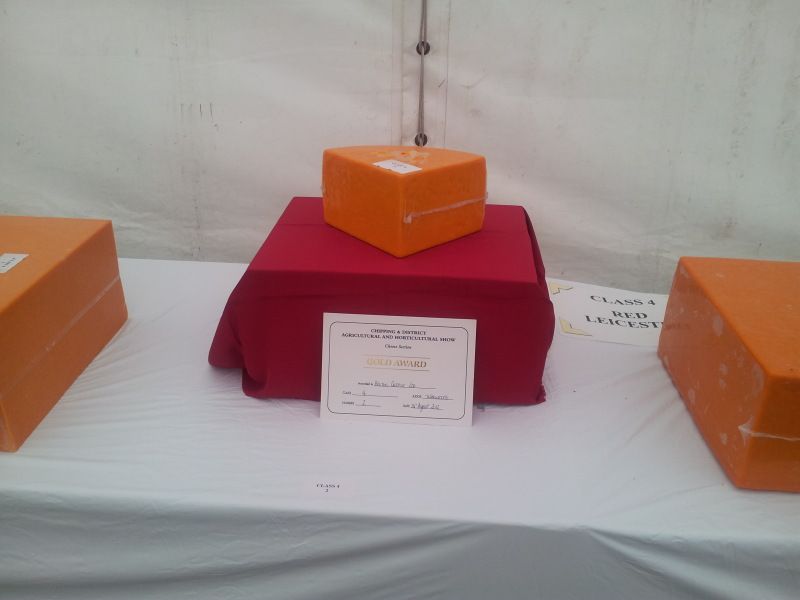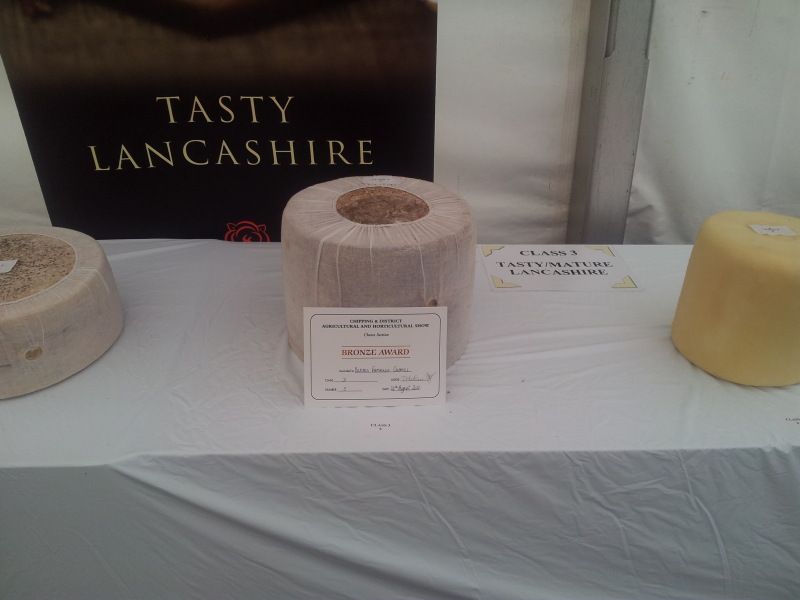I was the only one of the judges who wasn't a professional cheesemaker, though my great-great-great-great grandfather won prizes for cheese and butter at Whitewell and Whalley Shows in the 19th century.
There were around eighteen classes of cheese, most with 5 or more entries in each class.
Some judging was done in pairs, some just by one judge. I helped with the three types of Lancashire (creamy, crumbly and tasty), Red Leicesters, Wensleydales & other crumblies, and the blues.
There were two classes of cheese with "additives" (cheese with bits in) for which volunteers were called to judge. Everybody took the proverbial one step backwards, including me. Fortunately, Terry Hudson from First Milk (up Glasgow way) noticed nobody had done the Wensleydales yet and invited me to join him judging those, leaving the devilry that is cheese with additives to a couple of others. The howling of pain and imitation vomiting sounds from the 'additives' judges made me most glad I'd not be subjected to that.
It was interesting that, although they all make them, my fellow judges (all cheesemakers, remember) also seemed to pretty much dislike the additives cheeses on principle. But they sell. The occasional one is ok if you think of it in terms as a ready made rarebit, or cheese & pickle sandwich. Some of the drier cheeses like Wensleydale do take to a bit of fruit (or fruit cake), so you can sometimes see where the inspiration comes from. But most are just vile, not least as the manufacturing process seems to make the texture of the cheese go nasty. The winner in the savoury additives class was one of the few I recognised. A soft goats cheese flavoured with lemon zest and black pepper, made by Gill Mcmanaman, from Captra Goat Products of Longridge, who sells her goats cheese and milk at many of the local farmers' markets, and who's a good - if occasional - source for goat hearts and goat kidneys, both of which are delicious.
Like all good wine-tastings, all the cheeses were tasted blind. There were a couple that I knew what they were (e.g. Blacksticks Blue was pretty unmistakable), but for the most part there was nothing to identify them. Of course, it was only blind as to producer: it was, inevitably, blatantly obvious which were the industrial blocks and which were the artisan truckles.
Just like wine-tastings, there were some very good cheeses,some that were simply just a bit a dull, and (apart from those with additives), I think only one that was actively unpleasant. As we judges had to give a written tasting note in four categories (appearance, texture, body, taste) for each cheese, some of the descriptors I use when I'm trying to be kind in wine tasting, came in rather useful. "Muted" "Backward" "Closed" etc. ;)
One thing I found particularly interesting is that one of my prejudices was shattered. I've always worked on the basis that the best cheeses are the ones that look the most rustic, cloth-bound truckles, unpasteurised milk, bit of mould; that sort of thing. And the corollary is that those large oblong blocks of highly industrial-looking cheeses are the ones that are best avoided. That prejudice was completely blown out of the water.
It reminded me of the difference between "ordinary" wines and "natural" wines. Natural wines are like the more natural, rustic-looking cheeses. When they're good, they're great, but bottle variation is enormous, and the wild, funky notes can increasingly take over, losing any regional or varietal typicity.
Interestingly, the only cheese that was actively unpleasant was the most artisan-looking of the lot, with some rather wild-looking moulds on the exterior, and one I was particularly looking forward to, based on its appearance. It was revealed to be a Wensleydale that the dairy (I forget which) had pretty much forgotten about at the back of the store. But the texture had gone all grainy, yet pasty at the same time, the flavours were completely unbalanced, and - in wine terms - it was a real Musar or Beaucastel of a Wensleydale: all volatile acidity and animalistic sweaty horses!
The differences between cheeses in the same classes was remarkable, and not just between "natural" and more industrial types, though it was only when judging the tasty Lancashires that I and my fellow judge disagreed, though not hugely.
 |
| If you'd told me beforehand that I'd give a Red Leicester looking as plasticky as this the gold award over something like Butler's Rothbury Red, I would never have believed you. |
Butlers and Mrs Kirkham (probably the two biggest names in Lancashire cheese outside the region?) did reasonably well, though we had to disqualify one of the best cheeses there, a Butler's tasty Lancashire that had been entered in the creamy class. Lovely cheese, better than the tasty they'd entered in the tasty class, but a bit like passing off a Chilean Bordeaux Blend as Claret.
 |
| Some Tasty Lancashire rounds, all traditionally cloth-bound and then waxed |
 |
| A couple of unwaxed, traditionally cloth-bound Lancashire rounds (on the left) |
After the reveal, I was very surprised to hear that all three of the Lancashires to which I'd given the gold, were from the same producer: Greenfields, a small family dairy in Inglewhite. I know them mainly for their Sykes Fell, a Lancashire-style cheese that can't be called Lancashire, because it's made from sheeps' milk. You tend not to see many of their Lancashires, and I'm really not sure what their main outlet is.
All the judges got together to retaste all the gold medal winners from the different classes for a handful of awards, and an overall champion. The overall champion was a blue cheese - sold as Lancashire Blue - made by Carron Lodge, also near Inglewhite, but whom I know mainly as wholesalers and importers of cheese, rather than as cheesemakers.
 |
| The trophy winners |
